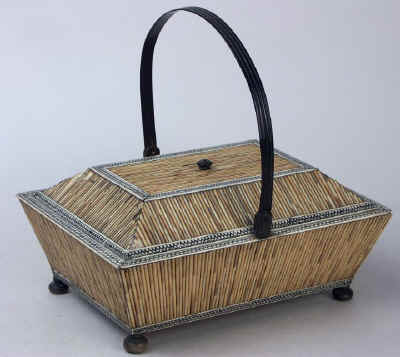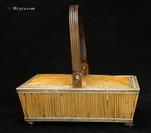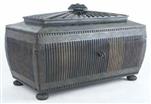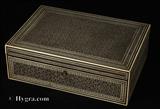|
| |
An Anglo Indian Vizagapatam radiating faded
black buffalo horn of dramatic curved shape Circa 1835
Please click on images to enlarge | slide show | thumbnail index |
high resolution
|
Description:
Ref: 753SB http://hygra.com/box/753SB/
Antique Anglo Indian, Vizagapatam, buffalo horn, fitted sewing box.
The radiating horn is molded and carved achieving a complex dramatic
shape. This is the Art of working with horn:
Created in small hierarchiced
workshops: buffalo horn was imported from nearby Jeypore
Zamindari.
These unnamed craftsmen had learned how to make a product which the
English market would buy. "Decorative artifacts were made by several craftsmen in 6 different teams working
for over 8 to 9 hours a day for a month."
Large
horns have been cut, softened by boiling then shaped by scraper,
lathe, and hand with abrasive.
A straight grained rosewood box with thick sides is first created. It
is then shaped; the tapers are in the construct.
The box is built from
elements, some manufactured by others in the group. The shape is
evolved from the English interpretation of the Classical art they were
being exposed to. The Indians created objects which
want to walk across the floor to meet you.
Origin: Vizagapatam,
India; Circa:
1835 ; Materials: Buffalo
horn, sandalwood on a rosewood structure.
Size: 33cm wide by 24cm by 21.5cm:
13 inches wide
by 9.5 inches by 8.5 inches.
Condition: good
overall; working lock and key; some cracking to horn see images
Keywords: Sewing box, horn, buffalo horn, Vizagapatam, Jeypore
Zamindari, Anglo Indian, sandalwood,
Request
current list of available sewing boxes with prices.
Request
current list of available writing boxes with prices.
Request
current list of available jewelry boxes with prices.
Request
current list of available tea caddies with prices.
boxes@hygra.com
|
 (Small).JPG)
a BOX with Attitude.
Group 1
Involves the planning and sanding sheets of wood.
Involves marking and cutting out of dovetails.
Assembling the boxes.
Artisans cut ivory into panels and strips, some of which are mounted on the box using
animal glue.
Engravers incised designs on strips of veneer
|

 (Small).JPG)
|
The craftsmen who made this box have
pushed the materials to the extreme to achieve this dramatic shape. The
radiating horn top is surmounted by a turned and carved knob which is
built in three layers.
|
Please click on images to enlarge | slide show | thumbnail index |
 (Small).JPG)
|
The inside has a lift out sandalwood
tray with horn edges and four radiating horn lids with turned horn
handles.
There is a further compartment in the
lid.
A British furniture factory
was established Vizagapatam in 1683
which was taken over by French
1757 and recaptured the following
year.
|
The sandalwood tray with tapering sides is constructed with
comb joints.
|
 (Small).JPG)
|
Please click on images to enlarge | slide show | thumbnail index |
| Side view. |
 (Small).JPG)
|
 (Small).JPG)
|
Back view. |
Please click on images to enlarge | slide show | thumbnail index |
Please click on images to enlarge | slide show | thumbnail index |
 (Small).JPG)
|
The knob is layered out of centered
geometry.
The topmost has 14
petals; that below has 14 too. The petals are brought to shape by
scraping and carving.
The petals are all slightly different, as are
things in nature.
, 14, 28, and always slightly out of line.
|
These forms were created by looking at the nature around.
|
 (Small).JPG)
|
Please click on images to enlarge | slide show | thumbnail index |
 (Small).JPG)
|
There is some cracking to the horn.
|
 (Small).JPG)
|
Inside the box has a compartmentalized lift out tray with supplementary
lids |
Please click on images to enlarge | slide show | thumbnail index |
|
The sewing tray
The sewing is constructed from from solid sandalwood.
The divisions are solid sandalwood too.
All is faced with horn.
There are five lidded compartments.
Eight of the spaces are for thread reels.
Four lids are radiating horn with turned horn knobs.
A tray for a turned horn thimble and another for the
tape-measure.
There are little silver handles on the sides for lifting the tray.
Everything is faced with horn.
The lock and the hinges are silvered.
|
 (Small).JPG)
|
Please click on images to enlarge | slide show | thumbnail index |
This is but a knob.
a flattened sheet of horn has been then lathe mounted and had its circular
shape created. It is then carved, and filed,
The design defies fast work.
The divisions of each concentric circle are out of line with each other in
an evolve.
|
 (Small).JPG)
|
A compartment for?
presentation. It is lined with sandalwood. I do not understand how wood
so old still gives out its perfume.
|
 (Small).JPG)
|
Please click on images to enlarge | slide show | thumbnail index |
 (Small).JPG)
|
The shape.
|
 (Small).JPG)
|
This is horn working pushed to the extreme: art.
The whole is somehow decadent. The reflections are so evocative.
The top knob in itself an artwork: two turned and scraped layers in a
design which is an abstraction of a flower.
The top has the radiating tapered level; each panel of horn has
been flattened glued to its surface. and then carved and scraped to shape.
The cavetto molding below has a whole sequence of other construction
problems to resolve.
The knob made and polished is put away till the box is made.
|
Please click on images to enlarge | slide show | thumbnail index |
References:
See Antique Boxes Tea Caddies Society
See: Furniture from British India and Ceylon Amin Jaffir
See: Luxury Goods from India: The Art of the Indian Cabinet-maker Amin Jaffer 2002
Other Anglo Indian boxes:
Below are some Anglo-Indian- boxes I have
documented on our site. It is becoming increasingly hard to find examples which
have survived with their integrity

 


 

.thumb.JPG)

.thumb.JPG)



All text and images and linked images are ©
1999-2015 Antigone Clarke and Joseph O'Kelly. If you require any further
information on permitted use, or a licence to republish any material, email us
at copyright@hygra.com
|
